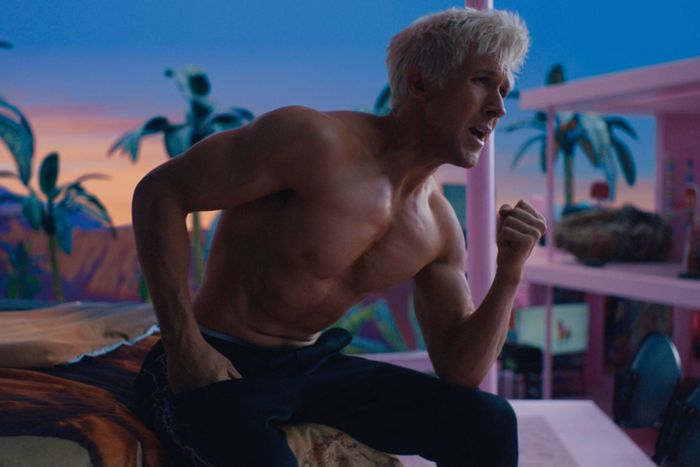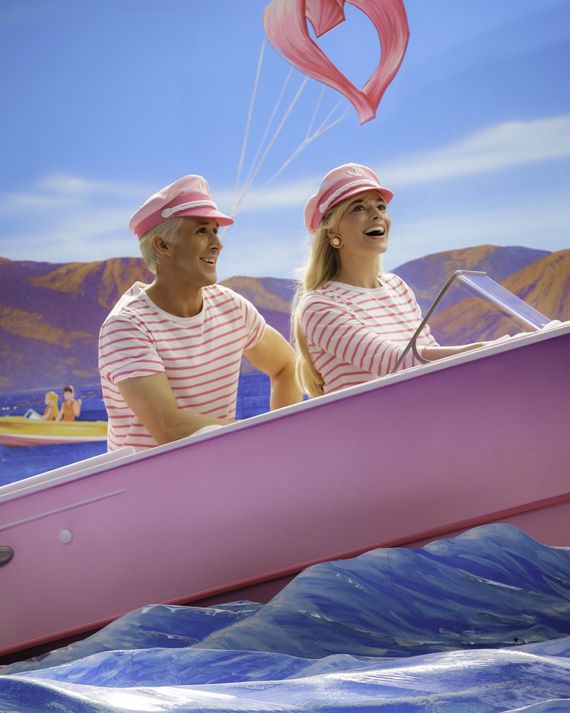
It’s the kind of montage that captures the breezy pleasures of summer itself. Barbie and Ken zip from the unreality of Barbie world by way of a baby-pink sports car that becomes a sailboat, then a spaceship, a tandem bike, a camper, a snowmobile, and, finally, a pair of Day-Glo ’80s Rollerblades delivering them into present-day Venice Beach. Margot Robbie and Ryan Gosling make choices in this montage that seem minor in constitution but are crucial in meaning. As they ride atop the spaceship, Gosling’s Ken holds onto their cardboard cutout-esque rocket while attempting to avoid its fiery thrust. He plays this moment frazzled, grounded only by the presence of Barbie at the helm, who Robbie positions as completely oblivious to danger, her face ecstatic. On the tandem bike, Gosling is heaving from exhaustion while Robbie is blissful and effortless; when she turns back to look at him, he perks up as if he isn’t about to keel over.
The back-and-forth is perfectly calibrated and sets the tone for the entire arc of Barbie. Gosling isn’t sucking up all the oxygen in the scene, he’s carefully tempering his presence so as to never dominate his scene partner. His physical humor isn’t driven by his own energetic mayhem, he’s giving in to the gravitational pull of his co-star. In Barbie, he embodies what is otherwise a rarity in Hollywood: a male star who is both interested in and capable of supporting a more richly constructed female lead.
It’s easy to get lost in the visual excess of the fuchsia fantasia that director-co-writer Greta Gerwig created. Barbie lives in a world without shame, without aging, without death, where every day is “perfectly perfect” and every evening is riven with musical numbers. Until Barbie brings a gargantuan dance party to a halt when she asks with earnest bubblegum-sweetness, “Do you guys ever think about dying?,” setting her off on a journey to the real world to heal whatever fractures exist in the girl playing with her. Ken tags along because Barbie is his sun, moon, and emotional center. The film smuggles into its acid-bright grooves jokes about fascism, women’s ability to juggle emotion and logic, and the banality of Zack Snyder’s Justice League cut, all while asking more meaningful questions about the nature of womanhood and existence itself.
Still, it’s been easy to criticize the film for being a giant Mattel marketing ploy and thus incapable of engaging with feminist ideals. It’s either nominated for too many Oscars (Gosling among them, for Best Supporting Actor) or nominated for too few (it has eight nominations in total), depending on where you fall in the greater debate. (For the record, that the Academy looks at Barbie and only rewards Ken isn’t irony. It’s also not true; America Ferrera is nominated for her supporting performance in the film as well. But that hasn’t stopped the worst white women you know from sorrowfully defending the film online, marking its lack of Best Director and Best Actress nominations as the most pressing examples of Hollywood’s misogyny — as if rich white women not being further feted by an industry that gives them such artistic latitude is sexism at all.)
It’s the kind of awards-season contention that overshadows a simple truth: Barbie is an actor’s delight, and Gosling’s performance is among its best.
There is a well of understanding behind Gosling’s portrayal of himboism. He’s been performing the public duties of a heartthrob since his Mickey Mouse Club days in the early 1990s, when he sang, danced, and smirked alongside budding megastars like Britney Spears. He broke out as an adult lead in The Notebook (2004), the first time he was asked to shine without obscuring the primacy of his female co-star, a dynamic he carried into more artful, lower-budget material like Half Nelson (2006, for which he earned his first Oscar nomination), Lars and the Real Girl (2007), and Blue Valentine (2010). In Lars, he honed an affinity for the brazenly weird and an ability to cut through banter, which served him well in Crazy Stupid Love (2011) and The Nice Guys (2016), the lighter fare he starred in before La La Land earned him his second Oscar nomination.
But these roles stand in stark contrast to the part that directly preceded Ken — the tepid, hypermasculine Courtland Gentry in the Russo brothers’ The Gray Man. In the Netflix original, Gosling is grim and emotionally removed in what filmmakers seemed to hope would be an acting turn in the lineage of the actor’s more serious movies to that point, like the noir Drive (2011). As the Driver, Gosling was all glare and clenched jaw. Physical stillness was key to his character, whose anger was always roiling beneath his surface. It was an exercise in the power of absence and subtraction that Gosling repeated in Blade Runner 2049, doubling down on a mumbling, chilly machismo. Gosling is the unmovable center of gravity in these films, leaning into the kind of star image that had worked for his Blade Runner scene partner, Harrison Ford, but made little use of the supporting charm and dexterity that put Gosling in his own echelon of present-day actors. These are films in which women — often Gosling’s greatest scene partners, against which he softens to the point of shape-shifting — are ornamental rather than genuinely realized.
Barbie doesn’t just take notice of Gosling’s charm and dexterity, it places them in juxtaposition to the attributes Robbie plays up for her Barbie. She makes for a genius straight man, matching Gosling’s zany preening with wide-eyed innocence and sweetness. In classic Hollywood, this dynamic wasn’t so novel — the women’s picture, popular in the 1930s through the ’50s, centered women in leading roles, wrestled with patriarchal norms, and spoke directly to women as their primary audience in the process. Movies like Now, Voyager and Clash by Night were crucial to the development of stars as different as Barbara Stanwyck, Katharine Hepburn, and Bette Davis, and required great male actors of the studio system like Cary Grant and Clark Gable to bend to the needs of their counterparts. Barbie is nothing if not a women’s picture, a movie that gleefully uncovers the machinations of modern womanhood, prioritizing fashion as an authentic means of that exploration. Gosling knows his place in a film like that, and so he trains his sherbet eyes upon Robbie, yearning for her approval, love, and importance.
In one of their greatest scenes together, Ken is far from riding back seat on a rocket to Southern California, where he learned about the patriarchy and decided it’s exactly what Barbie Land was missing. Barbie is now tasked with undoing what he’s wrought. Dressed in a magnificent magenta number with a Chanel purse to match, Barbie makes her way to Ken’s Mojo Dojo Casa House, formerly the Barbie Dreamhouse, in order to seduce him. She says she now wants to be his “long-term, long-distance, low-commitment, casual girlfriend.” He rebuffs her at first, despite clearly still eager for her approval. He rests his considerable bicep atop some saloon-style doors, flexing to make sure Barbie catches his best angles. She steps closer: “Please.” He says he needs to think about it, but only makes it a few steps inside before shouting, “Sublime!” We don’t see Gosling’s face when he makes the exclamation, but joy glimmers in his voice. Ken may be living a life of plastic, but for Gosling the emotionality is all real.
This is powerfully evident in “I’m Just Ken,” a lament of “blond fragility” and romantic longing performed by Gosling after the patriarchy he’s imported has begun to implode. The musical number harks back to 1952’s Singin’ in the Rain and 1951’s An American in Paris, with a broad flanking of Kens (including Simu Liu, Kingsley Ben-Adir, Ncuti Gatwa) moving in sync, singing and sizzling with enough energy to power a major American city. While Robbie plays Barbie as light as a sunbeam, Gosling’s performance is rooted, as swift as it is earthen, muscular like his predecessor Gene Kelly, making for a focal point the camera loves. When he balls his fists up, looks directly into the camera, his mink coat hanging just so on his impressive shoulders, and sings with trenchant need, “What will it take for her to see the man behind the tan and fight for me?,” his face carries a gentle smirk. It’s as if, in every step of the performance, in every swish and swivel, Gosling is encouraging audiences to swim in the pleasure of how much fun he’s having. If Robbie’s face always brims with sincerity, Gosling lets us in on the joke. But for all the actor’s silliness, there is an undercurrent of ache to his character. He hopes by performing the rigors of domineering, rugged machismo he can make sense of his desires, but it only makes him more miserable. What is a man without the harmful, corrosive effects of the patriarchy that imprisons us all?
When the original studio system crumbled in the 1960s and made way for New Hollywood in the 1970s, the women’s picture faded from view. Gone were the fiery, complex ways men related to women in their own stories, exiling the sexes to their own cinematic worlds. It wasn’t until the mid-budget movies of the 1980s and ’90s — in a variety of genres: erotic thriller, courtroom drama, rom-com — when male stars were once again expected to support their female counterparts, and sometimes even cede territory to them entirely. The lack of mid-budget masterworks today, a symptom of a franchise-obsessed industry, hasn’t just hobbled Hollywood’s ability to craft new generations of stars, it has made the way male and female stars interact onscreen seem more trite than consequential.
The last scene Barbie and Ken share distills what makes their interlocking performances such a pleasure to behold. In Barbie’s Dreamhouse — now restored alongside the matriarchy — Ken still struggles with his identity. “There is no just Ken. I only exist in the warmth of your gaze,” he tells Barbie, ripe with need. By this point, Barbie is steps away from gaining her humanity and leaving Barbie Land behind, having realized she’s spiritually outgrown her former life. “Maybe it’s time to discover who Ken is,” Barbie advises. “Maybe it’s Barbie and it’s Ken.” Ken, still down bad, can’t help but make a move. In one fluid motion, Gosling cradles and dips Robbie. When she calmly rejects him again, he slaps himself in the face and falls to the ground, projecting obvious hilarity but also a true sense of melancholy. It works because Gosling commits to every syllable of the revelation that follows: “Ken is me.” But it rises to the level of masterwork as he modulates his gestures and vocal dimensions in a way that centers Robbie’s reactions, as if how and when the punch line lands is up to her. With Barbie, we’re reminded of the electrical charge that runs through a film when a man understands his place isn’t in the spotlight but in supporting the woman who is under its glare.



